
|   |

|   |
Margazhi musings Text & pics: Lalitha Venkat e-mail: lalvenkat@yahoo.com December 31, 2014 Much has been written and discussed about dancers being unhappy over the sad state of dressing rooms in auditoriums - from their point of view. But there is always another side to any issue. From the perspective of Mr. Ramaswamy, the director of Bharatiya Vidya Bhavan, “We spend so much money on renovation and maintenance, but the dressing rooms are still messy as dancers smear the floor and furniture with alta when applying it on their hands and feet, and they also have this bad habit of sticking their sticker bindis on the mirrors. Why can’t they learn to be more considerate? When folk dance troupes perform in auditoriums, one can be assured of paan stains decorating the dressing room corners; that’s why we turn down programs featuring folk dance troupes.” Hmm. Definitely food for thought! 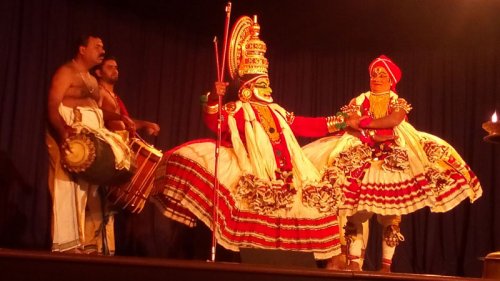 Sadanam Balakrishnan Post the Natya Darshan dance symposium, Kathakali Guru Sadanam Balakrishnan who won the lifetime achievement award from Kartik Fine Arts, shared a few interesting anecdotes off stage. He recalled a trip to Colombia where many international groups were featured in a festival. With a low crowd turnout, the organizers almost cancelled the rest of the shows. As luck would have it, the scenario changed for the better, so the fest continued and on the day Guru Sadanam Balakrishnan’s group performed, the hall was filled to capacity with an appreciative audience. Closer to home, he was slated to perform at NCPA in Mumbai and was asked how he ‘dared’ to showcase such a traditional dance at this particular venue. A workshop was conducted prior to the performance date and maybe it was partly due to that, the venue was overflowing with rasikas on the day of the performance. “It was so amazing. Both these instances prove that art truly has no language barriers,” he said in wonderment. Kathakali is a difficult dance form to understand and on his choice of presenting Salajjoham on the final evening of Natya Darshan, Sadanam Balakrishnan said that it was a very difficult piece, and was challenging for both the performer and the viewer. ‘The aesthetic and social worlds of courtesan dance in south India’ was an interesting and enlightening evening of lecture and demonstration by Dr. Davesh Soneji and Dr. Yashoda Thakore at the intimate Spaces venue. The first part was a talk aided by slides of historical documents and video clips of dances by Kalavantulu of Telugu speaking courtesan community. Davesh pointed out that Dr. Muthulakshmi Reddy was the daughter of Brahmin parents Chandrammal and Narayanaswami Iyer and did not belong to the devadasi community as is being popularly misrepresented. (This reminded me of Laxmipriya Mohapatra, the wife of Kelubabu, who told us candidly when we visited her in September in Bhubaneswar that it was incorrect to say she was the first woman to perform Odissi on stage as what she knew then were just 2 items taught to her and it was not called Odissi then!). The men of the Kalavantulu supported the anti-nautch campaign as they chose to benefit from that and signed the petition by Muthulakshmi Reddy in support! Some interesting excerpts of dance by the Kalavantulu were screened, and of special interest was an elderly lady miming to a song poking fun of a man’s virility with explicit movements! Speaking on the generosity of the devadasis, Davesh said they collected their jewels and gave them to Gandhiji to help raise funds for the salt satyagraha, but he rejected them by calling them tainted! Hailing from a Kalavantulu family, Dr. Yashoda Thakore presented brief items in their style of Kuchipudi that was both charming and captivating. 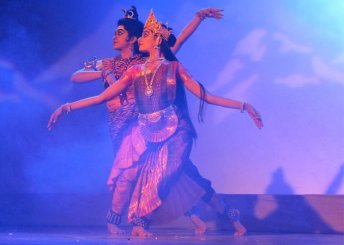

 Revathy Sankkaran  Pavitra Bhat in sthree vesham 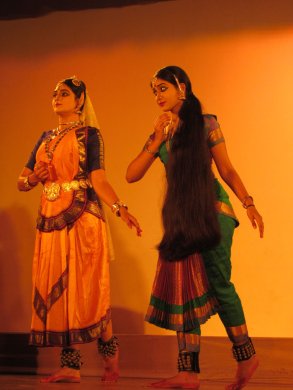 Lakshita Saravanan as Draupadi  Shruti Priya as Arjuna Anitha Guha is a successful choreographer and her Bharatanjali troupe charmed the audience with their meticulously presented Vana Virata Vijayam in 2 parts at Sivagami Pethachi Auditorium on two consecutive evenings. Instead of an impersonal intro, Revathy Sankkaran, with her customary panache, played the sutradhar explaining the scenes to come laced with witticisms that was a big hit with the audience. Superb casting of the characters, evocative score, diverse choreographic inputs and good looking dancers delivering a good performance drew in full houses at a time when dwindling audiences seems to be the hot topic for discussions. Also the seamless proceeding of one scene into another without needless gaps adds a polish to the presentation. Lakshita Saravanan as Draupadi was the envy of everyone, her long straight tresses cascading down to her knees! Padmini lookalike Shruti Priya as Arjuna wowed the audience by standing with closed eyes and folded hands in the tapas pose on one leg for a whole ten minutes without moving a muscle – a feat indeed when most dancers cannot hold a pose for even a few seconds! Pavitra Bhat in stree vesham (in part 2) had the audience wondering if it was indeed a female they were looking at, so graceful was he. Sathvikaa Shankar as Keechakan as well as other roles proved that she can easily get into the skin of any character she portrays. There was never a dull moment as the Mahabarata characters came alive on stage and the group earned a well deserved standing ovation. A standing ovation has to be earned, not demanded as was the case at another venue by a prominent dance guru who was present in the audience, for a mediocre group presentation. People actually walked out in protest at this imposition. If the performer is an established artiste, audience feels compelled to give a standing ovation regardless of the quality of performance… sigh! 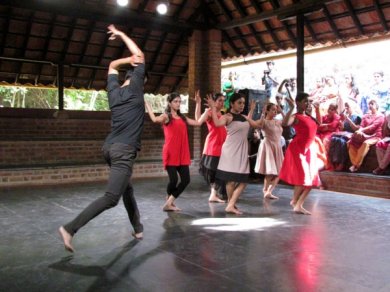

Padme
When Float with music by pianist Anil Srinivasan and percussion by
Krishna Kishor, followed by contemporary dance Padme by a group of 7
dancers from Bangalore (auditioned by Arangham Trust) was presented on
Christmas morning at 7.45am at Spaces, little did one expect almost 250
strong audience at that early hour. Not only that, they all stayed back
for an invigorating Q & A with the dancers and choreographer Kalpana
Raghuraman followed by breakfast hosted by Arangham. The booklet ‘Did U
Know’ with snippets culled from the narthaki.com archives, specially
published for the season, was distributed free to the guests. This well
attended event shows how Chennai welcomes innovation in content and
recognizes quality, so while sabha crowds are certainly dwindling,
audiences for the alternate are growing.Every year, the Natya Darshan symposium of Kartik Fine Arts takes place before the Natya Kala Conference of Krishna Gana Sabha, so the rasikas are able to attend both. The third morning of the Natya Kala Conference featured Kuchipudi dancer Nandini Nitin speaking on Usha, the daughter of demon king Banasura. Contemporary / Kathak dancer Madhu Nataraj Kiran spoke on Vrinda / Tulasi, the wife of the asura Jalandhara. “Revisiting of lesser known characters from Indian mythology” brought to light many stories involving the key characters and how they are interpreted in dance, paving the way for more elaborate dance features on the subject in future. Both dancers wore striking costumes and the sincerity of their presentations touched the audience 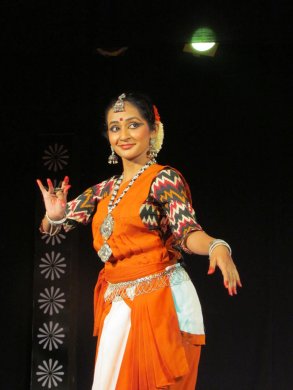 Nandini Nitin 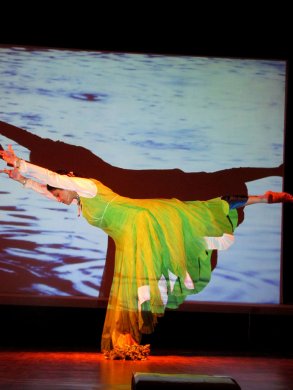 Madhu Nataraj Kiran The most interesting aspect of the much publicized premiere of dance theatre ‘Swappnam’ by Na Maargam Dance Company was the art exhibition in the lobby of Sir Mutha Venkatasubba Rao Auditorium by a group of select artistes by way of sculpture, graphic art, collage, painting etc. These were produced in response to the music composed by maestro Ilayaraja for the production and the artists present were only too happy to share their creative process with the visitors. Lalitha Venkat is the content editor of www.narthaki.com |